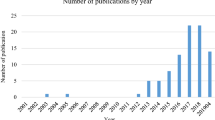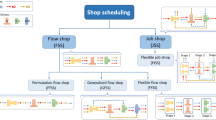Abstract
In this research, a manufacturing facility with independent workstations to remanufacture nonconforming products is investigated. Each workstation is first modeled as an M/M/m queuing system with m being a decision variable. Then, a tri-objective integer nonlinear programming models is developed to formulate the problem. The first objective tries to minimize the waiting times of products, while the second one tries to maximize the minimum reliability of machines at the workstations. Since minimization of the waiting times results in using a large number of machines with higher idle times, the third objective is considered to minimize the mean idle time of the machines. The aim is to determine optimal number of machines at each workstation. Since the problem belongs to the class of NP-hard problems, the non-dominated sorting genetic algorithm-II (NSGA-II) is utilized to find Pareto fronts. Because there is no benchmark available in the literature to validate the results obtained, the non-dominated ranked genetic algorithm (NRGA) is used as well. In both algorithms, not only the best operators are selected but also all of their important parameters are calibrated using statistical analysis. The performances of the algorithms are statistically compared using the t test. Besides, the multiple attribute decision-making method of TOPSIS is used to determine the better algorithm. The applicability of the proposed model and the solution algorithms is demonstrated via some illustrative examples.
Similar content being viewed by others
References
Toktay LB, Wein LM, Zenios SA (2000) Inventory management of remanufacturable products. Manag Sci 46(11):1412–1426
Souza GC, Ketzenberg ME (2002) Two-stage make to order remanufacturing with service-level constraints. Int J Prod Res 40(2):477–493
Bayindir ZP, Erkip N, Gullu R (2003) A model to evaluate inventory costs in a remanufacturing environment. Int J Prod Econ 81–82:597–607
Ketzenberg ME, Souza GS, Guide VDR (2003) Mixed assembly and disassembly operations for remanufacturing. Prod Oper Manag 12(3):320–325
Vorasayan J, Ryan SM (2006) Optimal price and quantity of refurbished products. Prod Oper Manag 15(3):369–383
Lieckens K, Vandaele N (2007) Reverse logistics network design with stochastic lead times. Comput Oper Res 34(2):395–416
Gayon, J. P (2007) A make-to-stock queue with product return. Working paper ( http://www.g-scop.inpg.fr/gayonj/)
Li Y, Chen J, Cai X (2007) Heuristic genetic algorithm for capacitated production planning problems with batch processing and remanufacturing. Int J Prod Econ 105(2):301–317
Demirel NO, Gokcen H (2008) A mixed integer programming model for remanufacturing in reverse logistics environment. Int J Adv Manuf Technol 39(11–12):1197–1206
Zerhouni H, Gayon, Jean-Philippe, F Yannick (2009) Influence of product return lead-time on inventory control. International Conference on Industrial Engineering and Systems Management IESM
Jin X, Ni J, Koren Y (2011) Optimal control of reassembly with variable quality returns in a product remanufacturing system. CIRP Ann - Manuf Technol 60(11):25–28
Karamouzian A, Teimoury E, Modarres M (2011) A model for admission control of returned products in a remanufacturing facility using queuing theory. Int J Adv Manuf Technol 54(1–4):403–412
Lieckens KT, Colen PJ, Lambrecht MR (2013) Optimization of a stochastic remanufacturing network with an exchange option. Decis Support Syst 54(4):1548–1557
Huang SM, Su JCP (2013) Impact of product proliferation on the reverse supply chain. Omega 41(3):626–639
Diabat A, Kannan D, Kaliyan M, Svetinovic D (2013) An optimization model for product returns using genetic algorithms and artificial immune system. Resour, Conserv Recycl 74:156–169
Kleinrock L (1975) Queuing systems. Wiley, New York
Gross D, Harris CM (1984) Fundamentals of queuing, 2nd edn. Wiley, New York
Deb K, Pratap A, Meyarivan T (2000) A fast elitist non-dominated sorting genetic algorithm for multi-objective optimization: NSGA-II. Parallel Problem Solving Nat 4(1):849–858
Al Jadaan, O., Rajamani, L, Rao, C.R (2008) Non-dominated ranked genetic algorithm for solving multi-objective optimization problems. Journal of Theoretical and Applied Information Technology, CiteSeerx, doi:10.1.1.207.9427
Al Jadaan, O. Rao, C.R., Rajamani, L. Ranked based roulette wheel selection method. ISRAMA2005, Calcutta mathematical Society, (2005).
Neter J, Kutner MH, Nachtsheim CJ, Wasserman W (1996) Applied linear regression models. McGraw-Hill, Chicago
Montgomery DC (2009) Design and analysis of experiments, 7th edn. John Wiley & Sons, Asia
Zitzler E, Deb K, and Thiele, L (1999) Comparison of multiobjective evolutionary algorithms: empirical results (revised version). Technical Report 70, Computer Engineering and Networks Laboratory (TIK), Swiss Federal Institute of Technology (ETH) Zurich, Gloriastrasse 35, CH-8092 Zurich, Switzerland
Tzeng G-H, Huang J-J (2011) Multiple attribute decision making, methods and applications. Taylor and Francis Group
Author information
Authors and Affiliations
Corresponding author
Rights and permissions
About this article
Cite this article
Pasandideh, S.H.R., Niaki, S.T.A. & Maleki, L. A queuing approach for a tri-objective manufacturing problem with defects: a tuned Pareto-based genetic algorithm. Int J Adv Manuf Technol 73, 1373–1385 (2014). https://doi.org/10.1007/s00170-014-5896-2
Received:
Accepted:
Published:
Issue Date:
DOI: https://doi.org/10.1007/s00170-014-5896-2




